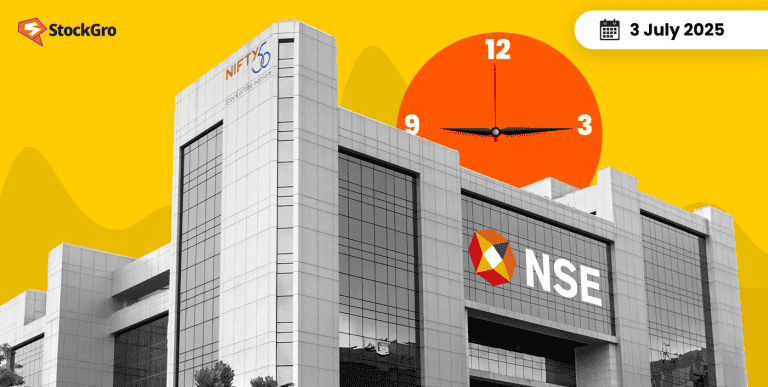
India’s banking industry is poised for strong growth in 2025, with credit expansion expected to achieve a double-digit growth rate of 10%. Transaction volumes in digital payments have soared to 8,659 crores in just the first five months of FY 2024-25, marking rapid fintech adoption and government support. The sector’s growing contribution to GDP highlights its increasing importance in the economic landscape. Keep reading to learn about the best bank penny stocks in India for 2025.
Also Read: Investing in Bank Stocks: Are They Right for Your Portfolio?
Top bank penny stocks in India
Here are the top bank sector penny stocks based on their current price, from lowest to highest, as of June 24, 2025:
| Name | Current Price (₹ ) | Market capitalisation (₹ crores) | P/E ratio | ROE % | ROCE % | Debt to equity ratio |
| Yes Bank Ltd | 20.0 | 62,631 | 25.6 | 5.44 | 6.36 | 7.45 |
| Utkarsh Small Finance Bank Ltd | 23.6 | 2,604 | 110 | 0.80 | 7.17 | 8.04 |
| Dhanlaxmi Bank Ltd | 29.0 | 1,142 | 17.1 | 5.50 | 5.47 | 11.6 |
| UCO Bank | 29.8 | 37,330 | 15.3 | 8.38 | 5.76 | 10.4 |
| South Indian Bank Ltd | 29.9 | 7,815 | 6.00 | 13.8 | 6.50 | 11.1 |
Yes Bank Ltd
Yes Bank Ltd, a private sector bank, was formed in 2003 and its headquarters are located in Mumbai. The bank is engaged in providing a variety of financial services like retail and corporate. Yes Bank has a large number of branches and ATMs and it has also invested in digital and customer service initiatives.
With Sumitomo Mitsui Banking Corporation becoming the biggest shareholder of Yes Bank and indicating a major strategic alliance for Yes Bank’s next phase of development, SMBC is positioned to buy a 20% ownership. Even after the SMBC deal, State Bank of India (SBI) will continue to be a prominent Yes Bank shareholder with over 10%.
Assessing quarterly results can support informed investment choices.
| Particulars | March 2025 (₹ Crores) | March 2024 (₹ Crores) |
| Sales | 7,623 | 7,458 |
| Financing Profit | -809 | -1,191 |
| Net Profit | 745 | 467 |
| EPS (₹) | 0.24 | 0.16 |
Also Read: Are Penny Stocks Worth the Risk in 2025?
Utkarsh Small Finance Bank Ltd
Utkarsh Small Finance Bank Ltd was established in 2009 and its main office is located in Varanasi, India. The bank provides a variety of financial services which include savings and current accounts, fixed and recurring deposits, loans for MSMEs, micro-banking, housing, and commercial vehicles in addition to insurance and investment products.
By the end of March 2025, it had 1,092 branches across 27 states and union territories. As of June 2025, Utkarsh Small Finance Bank Ltd’s market capitalisation is around ₹2,604 crore.
Reviewing the quarterly performance can help make better investment decisions.
| Particulars | March 2025 (₹ Crores) | March 2024 (₹ Crores) |
| Sales | 879.62 | 895.62 |
| Financing Profit | -275.83 | 87.67 |
| Net Profit | 2.97 | 159.66 |
| EPS (₹) | 0.03 | 1.45 |
Dhanlaxmi Bank Ltd
Dhanlaxmi Bank Ltd was founded in 1927 and has its main office in Thrissur, Kerala. The bank is most notable for its old brand and its faith in personalised banking. Dhanlaxmi Bank has been growing its banking network and utilising modern banking technologies for customers of different types of businesses till now.
At the end of March 2025, the bank had managed 261 branches and 282 ATMs in India. By June 2025, its market cap is around ₹1,142 crore.
Quarterly financial updates can provide valuable insights for investment strategies.
| Particulars | March 2025 (₹ Crores) | March 2024 (₹ Crores) |
| Sales | 351 | 306 |
| Financing Profit | -16 | -30 |
| Net Profit | 29 | 3 |
| EPS (₹) | 0.73 | 0.08 |
UCO Bank
UCO Bank (United Commercial Bank) was established in 1943 and is a government-owned public sector bank with a primary office in Kolkata The bank focuses on financial services in various areas such as retail and corporate banking, treasury, and international banking, and even has branches abroad in Singapore and Hong Kong.
UCO Bank operates 3,302 domestic branches, 2 overseas branches, 2,522 ATMs, and 10,653 business correspondent points across India. The market capitalisation of UCO Bank is about ₹37,330 crore, as of June 2025.
Assessing quarterly results can support informed investment choices.
| Particulars | March 2025 (₹ Crores) | March 2024 (₹ Crores) |
| Sales | 6,745 | 5,860 |
| Financing Profit | -356 | -319 |
| Net Profit | 652 | 526 |
| EPS (₹) | 0.52 | 0.44 |
South Indian Bank Ltd
South Indian Bank Ltd was established in 1929 and is one of the major private sector banks in India, with its head office located in Thrissur, Kerala. The bank is a pioneer in the Indian banking sector in service and innovation. By 2025, the bank will operate an extensive branch network, ultra-small branches, satellite branches, ATMs, and cash recycler machines across multiple states and union territories of India.
For FY2024-25, South Indian Bank reported its highest-ever net profit of ₹1,303 crore, with a return on assets of 1.05% and a return on equity of 12.90%.
Quarterly financial updates can provide valuable insights for investment strategies.
| Particulars | March 2025 (₹ Crores) | March 2024 (₹ Crores) |
| Sales | 2,373 | 2,275 |
| Financing Profit | -113 | 47 |
| Net Profit | 342 | 288 |
| EPS (₹) | 1.31 | 1.10 |
Also Read: Ten Basic Terminologies That You Should Know About Indian Banking
Conclusion
In 2025, the Indian banking sector is going through a remarkable phase of growth, which is a result of increasing credit demand and also technological advancements in digital banking. These stocks depict such trends and are usually referred to in the context of the sector’s growth. In comparison to the big banks, these stocks usually have characteristics of higher volatility and uncertainty. With the banking sector still expanding, bank penny stocks are still a unique focus in India’s stock market.
FAQs
Usually, evaluating bank sector penny stocks requires a study of important financial indicators and firm fundamentals. Among important indicators are price-to-earnings (P/E), price-to-book (P/B), return on equity (ROE), current ratio, and debt-to-equity ratio. These ratios enable the assessment of profitability, value, liquidity, and leverage. Furthermore, providing context for analysing the financial situation and prospects of bank penny stocks are key variables, including earnings growth, balance sheet strength, market trends, and the regulatory environment.
HDFC Bank Ltd, State Bank of India (SBI), ICICI Bank Ltd, Axis Bank Ltd, and Kotak Mahindra Bank Ltd are some of the most well-known banking companies in India. Among the biggest banks nationwide, these have a major presence in the financial industry and large networks. Often they feature in conversations with top Indian banking companies.
India’s bank penny stock is made up of shares of banking firms trading below ₹10 per share. Compared to major banks, these equities usually have low market capitalisation, sparse financial history, and less liquidity. Bank penny stocks are regarded as a separate area in the Indian stock market and can have large price changes.
Based on current prices, some of the finest bank penny stocks in India are Dhanlaxmi Bank Ltd, Yes Bank Ltd, and Utkarsh Small Finance Bank Ltd. Operating large networks across many areas, these banks are well-known for their established presence in the Indian banking industry. In conversations about affordable banking companies in India’s changing financial environment, their shares are often emphasised.
The price of bank penny stocks can be influenced by a number of variables such as interest rate swings, liquidity, and company-specific announcements or financial results. Changes in pricing are influenced by regulatory changes, industry trends, and general economic conditions as well. Furthermore impacted by speculative behaviour, these stocks often have low trading volumes and can show significant price swings.

